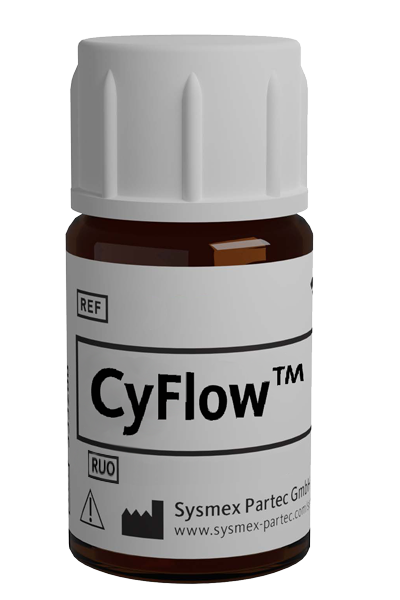CyFlow™ Beta3-tubulin FITC

| Antibody: | Yes |
| Antigen: | β3-tubulin |
| Application: | Immunocytochemistry |
| Clonality: | monoclonal |
| Clone: | TU-20 |
| Emission Maximum: | 518 nm |
| Excitation Maximum: | 490 to 495 nm |
| Field of Interest: | Cytoskeleton, Neurobiology |
| Format/Fluorochrome: | FITC |
| Isotype: | IgG1 |
| Laser: | Blue |
| Regulatory Status: | RUO |
| Source Species: | Mouse |
| Target Species: | Broad Spectrum |
| Product number: | AR041515 |
For Research Use Only
| Concentration Unit | mg/mL |
| Concentration | 1 |
| Quantity | 0.1 mg |
| Volume | 0.1 mL |
| Immunogen | Peptide (C) 441-448 coupled to maleimide-activated keyhole limpet hemocyanin via cysteine added to the N-terminus of the neuron-specific peptide |
| Background Information | β3-tubulin isoform is present dominantly in cells of neuronal origin and it is one of the earliest markers of neuronal differentiation. It is regarded as a specific probe for the cells of neuronal origin as well as for the tumors originating from these cells. The β3-tubulin is most abundant in cells of neuronal origin, but was also detected in Sertoli cells of the testis and transiently in non-neuronal embryonic tissues. |
| Usage | The reagent is designed for Immunocytochemistry. Suggested working usage is 2.5·µg/ml. The conjugate was also successfully used on paraffin sections using confocal microscopy. Working concentrations should be determined by the investigator. |
| Storage Buffer | The reagent is provided in phosphate buffered saline (PBS) solution, pH ≈7.4, containing 0.09% (w/v) sodium azide. |
| Storage | Avoid prolonged exposure to light. Store in the dark at 2-8°C. Do not freeze. |
| Stability | Do not use after expiration date stamped on vial label. |
| Draberova E, Lukas Z, Ivanyi D, Viklicky V, Draber P: Expression of class III beta‑tubulin in normal and neoplastic human tissues.. Histochem Cell Biol. 1998 Mar; 109(3):231‑9. < PMID: 9541471 > | Peknicova J, Kubatova A, Sulimenko V, Draberova E, Viklicky V, Hozak P, Draber P: Differential subcellular distribution of tubulin epitopes in boar spermatozoa:recognition of class III beta‑tubulin epitope in sperm tail. Biol Reprod. 2001 Sep; 65(3):672‑9. < PMID: 11514327 > | Kukharskyy V, Sulimenko V, Macůrek L, Sulimenko T, Dráberová E, Dráber P: Complexes of gamma‑tubulin with nonreceptor protein tyrosine kinases Src and Fynin differentiating P19 embryonal carcinoma cells. Exp Cell Res. 2004 Aug 1; 298(1):218‑28. < PMID: 15242776 > | Jirasek T, Pisarikova E, Viklicky V, Mandys V: Expression of class III beta‑tubulin in malignant epithelial tumours: an immunohistochemical study using TU‑20 and TuJ‑1 antibodies. Folia Histochem Cytobiol. 2007; 45(1):41‑5. < PMID: 17378245 > | Katsetos CD, Dráberová E, Smejkalová B, Reddy G, Bertrand L, de Chadarévian J-P, Legido A, Nissanov J, Baas PW, Dráber P: Class III beta‑tubulin and gamma‑tubulin are co‑expressed and form complexes in human glioblastoma cells.. Neurochem Res. 2007; 32:1387‑1398. < PMID: 20162618 > | Jirásek T, Cipro S, Musilová A, Kubecová M, Mandys V: Expression of class III beta‑tubulin in colorectal carcinomas: an immunohistochemical study using TU‑20&TuJ‑1 antibody. Indian J Med Res. 2009 Jan; 129(1):89‑94. < PMID: 19287064 > | Theodorou E, Dalembert G, Heffelfinger C, White E, Weissman S, Corcoran L, Snyder M: A high throughput embryonic stem cell screen identifies Oct‑2 as a bifunctional regulator of neuronal differentiation. Genes Dev. 2009 Mar 1; 23(5):575‑88. < PMID: 19270158 > | Dráberová E, Sulimenko V, Vinopal S, Sulimenko T, Sládková V, D'Agostino L, Sobol M, Hozák P, Křen L, Katsetos CD, Dráber P: Differential expression of human γ‐tubulin isotypes during neuronal development and oxidative stress points to a γ‐tubulin‐2 prosurvival function. FASEBJ. 2017 May; 31(5):1828‐1846. < PMID: 28119396 >
